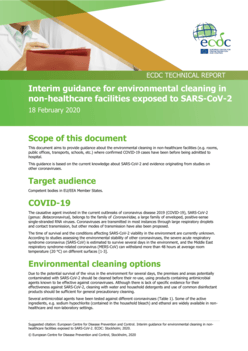Hello! You're looking at a policy document report on Overton
We track government policy, guidelines, think tank research, working papers and more to help our customers see the impact and influence of their work. Are you interested in seeing what information we have to offer? Request a free trial to our platform.
If you fund, produce or manage research or work to influence policy, we'd love to talk. Learn more on our homepage.

Identifiers
Overton ID
ecdc-20f4ed8816d371f9401d281cb84e2eb7
Interim guidance for environmental cleaning in non-healthcare facilities exposed to SARS-CoV-2
This document aims to provide guidance about the environmental cleaning in non-healthcare facilities (e.g. rooms, public offices, transports, schools, etc.) where confirmed COVID-19 cases have been before being admitted to hospital. This guidance is based on the current knowledge about SARS-CoV-2 and evidence originating from studies on other coronaviruses.
Topics in this document
Public health
Medical specialties
Coronavirus
Microbiology
Health sciences
Health
Personal protective equipment
Transmission (medicine)
Middle East respiratory syndrome
Sodium hypochlorite
Infection
Bleach
Medicine
Coronaviridae
Viruses
Diseases and disorders
Antimicrobial
Clinical medicine
Virus
Severe acute respiratory syndrome-related coronavirus
Hypochlorite
Epidemiology
Tree of life (biology)
Clinical pathology
Infectious diseases
Chemistry
Disease
Related SDGs
SDG 3: Good Health and Well-being ...
SDG 3: Good Health and Well-being
Target 3.d
Strengthen the capacity of all countries, in particular developing countries, for early warning, risk reduction and management of national and global health risk
Cites research funded by
Citations
Cited by 67
other policy documents
(56 of them are from other policy sources)
